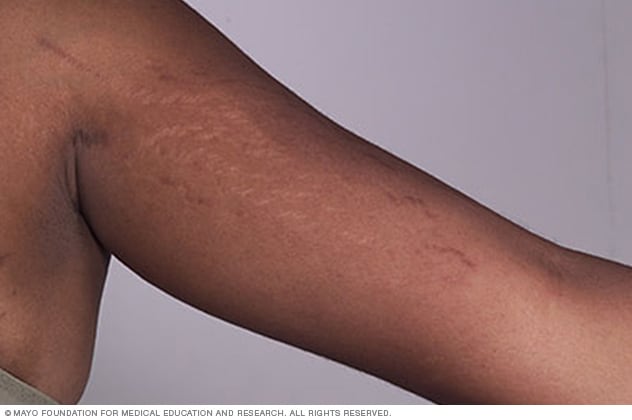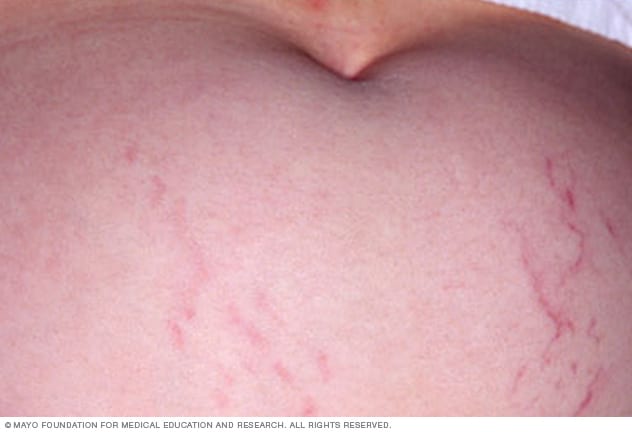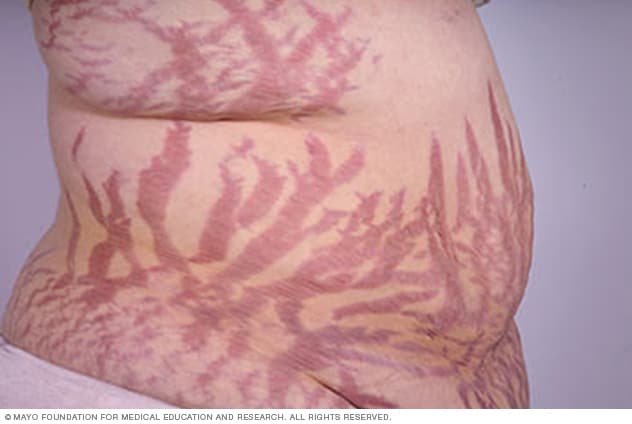Stretch marks
Stretch marks
overview
Stretch marks on the arm

Stretch marks on the arm
Some men and women tend to develop stretch marks on their upper arms, abdomen, buttocks, and thighs. New stretch marks are light pink, red, blue, black, or purple. Older stretch marks fade.
Stretch marks (striae) are indented stripes that appear on the stomach, breasts, hips, buttocks, or other parts of the body. They are common in pregnant women, especially during the last trimester. Stretch marks aren't painful or harmful, but some people don't like the way their skin looks.
Stretch marks do not require any treatment. They often fade over time, with or without treatment. They may never completely disappear.
Symptoms
Stretch marks during pregnancy

Stretch marks during pregnancy
Stretch marks are common in pregnant women, especially in the last trimester. They often fade but usually do not disappear.
Widespread stretch marks

Widespread stretch marks
Stretch marks can cover large areas of the body, but are rare. This can be caused by taking corticosteroids or a condition such as Cushing's syndrome.
Not all stretch marks look the same. They vary depending on how long you've had them, what caused them, where they are on your body, and what type of skin you have. Common variations include:
- Eingedrückte Streifen oder Linien an Bauch, Brüsten, Hüften, Gesäß oder anderen Körperstellen
- Rosa, rote, schwarze, blaue oder violette Streifen
- Helle Streifen, die zu einer helleren Farbe verblassen
- Streifen, die große Bereiche des Körpers bedecken
When to go to the doctor?
See your doctor if you are concerned about the appearance of your skin or if the stretch marks cover large areas of your body. Your doctor can help you determine the cause of the stretch marks and discuss treatment options.
Causes
The cause of stretch marks is the stretching of the skin. Its severity is influenced by several factors, including your genetics and the level of stress on the skin. Your levels of the hormone cortisol could also play a role. Cortisol – a hormone produced by the adrenal glands – weakens elastic fibers in the skin.
Risk factors
Anyone can develop stretch marks, but some factors increase your chances of getting them, including:
- Weiblich sein
- Eine persönliche oder familiäre Geschichte von Dehnungsstreifen haben
- Schwanger sein, besonders wenn Sie jung sind
- Schnelles Wachstum in der Jugend
- Schnelle Gewichtszunahme oder -abnahme
- Verwendung von Kortikosteroiden
- Eine Operation zur Brustvergrößerung haben
- Ausübung und Verwendung von anabolen Steroiden
- Eine genetische Störung wie das Cushing-Syndrom oder das Marfan-Syndrom haben
Sources:
- Kang S, et al., Hrsg. Hautveränderungen und Erkrankungen in der Schwangerschaft. In: Fitzpatricks Dermatologie. 9. Aufl. McGraw-Hügel; 2019. https://accessmedicine.mhmedical.com. Abgerufen am 10. November 2020.
- Ferri FF, et al., Hrsg. Striae (Dehnungsstreifen). In: Ferri’s Fast Facts in Dermatology: A Practical Guide to Skin Diseases and Disorders. 2. Aufl. Elsevier; 2019. https://www.clinicalkey.com. Abgerufen am 10. November 2020.
- Landon MB, et al., Hrsg. Hauterkrankungen und Schwangerschaft. In: Gabbe’s Obstetrics: Normal and Problem Pregnancies. 8. Aufl. Elsevier; 2021. https://www.clinicalkey.com. Abgerufen am 10. November 2020.
- Wick MJ, Hrsg. Monat 8: Wochen 29 bis 32. In: Mayo Clinic Guide to a Healthy Pregnancy. 2. Aufl. Mayo-Klinik; 2018.
- Kutlubay Z, et al. Die Hautfarbe: Braune Erkrankungen der Haut, Nägel und Schleimhäute. Kliniken für Dermatologie. 2019; doi.org/10.1016/j.clindermatol.2019.07.007.
- MacGregor JL, et al. Striae distensae (Dehnungsstreifen). https://www.uptodate.com/contents/search. Abgerufen am 2. Dezember 2020.

 Suche
Suche
 Mein Konto
Mein Konto